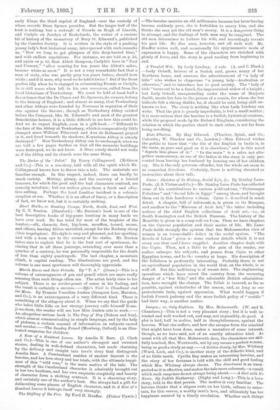• Cloister Life in the Days of Cceur de Lion.
By Dr. Spence, Dean of Gloucester. (Isbieter and Co.)—When we have praised Mr. Railton's beautiful architectural illustrations, we have praised all that can be praised in this book. As a mere gift-book, its illus- trations may well carry it into many drawing-rooms. But its title is most misleading, and its profession of being "studies in a half- forgotten life" is a "frost." From the Dean of Gloucester we were entitled to expect that a book called Cloister Life in the Days of Coeur de Lion, would contain some new light, if not results of original research, on the inner conditions of monastic life, and that one hoped, in the monastery of Gloucester—in the time of our
early Kings the third capital of England—over the custody of whose records Dean Spence presides. But the larger half of the book is nothing but a rechauffei of Fronde on Hugh of Lincoln, and Carlyle on Jocelyn of Brakolonde, the writer of a curious bit of history of the monastery of Bury St. Edmund's, published by the Camden Society. It is written in the style of a gushing young lady's first historical essay, interspersed with such remarks as, "How we long to get glimpses of this deep-buried time," and with endless repetitions. For instance, we are told on p. 56, and again on p. 62, that Abbot Sampson, Carlyle's hero in "Past and Present," " after wearing for ten years the Abbot's mitre, became white as snow." It is not a very remarkable fact that a man of sixty, who was partly grey ten, years before, should turn white ; and if it were, why need we be told it twice P But if the Dean gushes idly when he is engaged in eviscerating Fronde or Carlyle, he is still worse when left to his own resources, culled from the local historians of Tewkesbury. We must be told at least half a dozen times that the De Clares and De Spensers,its owners, belong to the history of England ; and almost as many, that Tewkesbury and other Abbeys were founded by Normans in expiation of their sins against the Saxons ; though as Tewkesbury Abbey existed before the Conquest, like St. Edmund's and most of the greatest Benedictine houses, it is a little difficult to see how this could be. And we do expect English, even in a gift-book :—" Different to the fate of the Abbey at Tewkesbury, which is comparatively little changed since William Fitzcount and Ann de Bellamont prayed in it, and lived beneath its shadows, Keynsham Abbey is utterly destroyed." How Tewkesbury Abbey can be unchanged, when we are told a few pages further on that all the monastic buildings were destroyed, we do not know. A Dean surely should not write as if the Abbey and its church were the same thing.



































 Previous page
Previous page